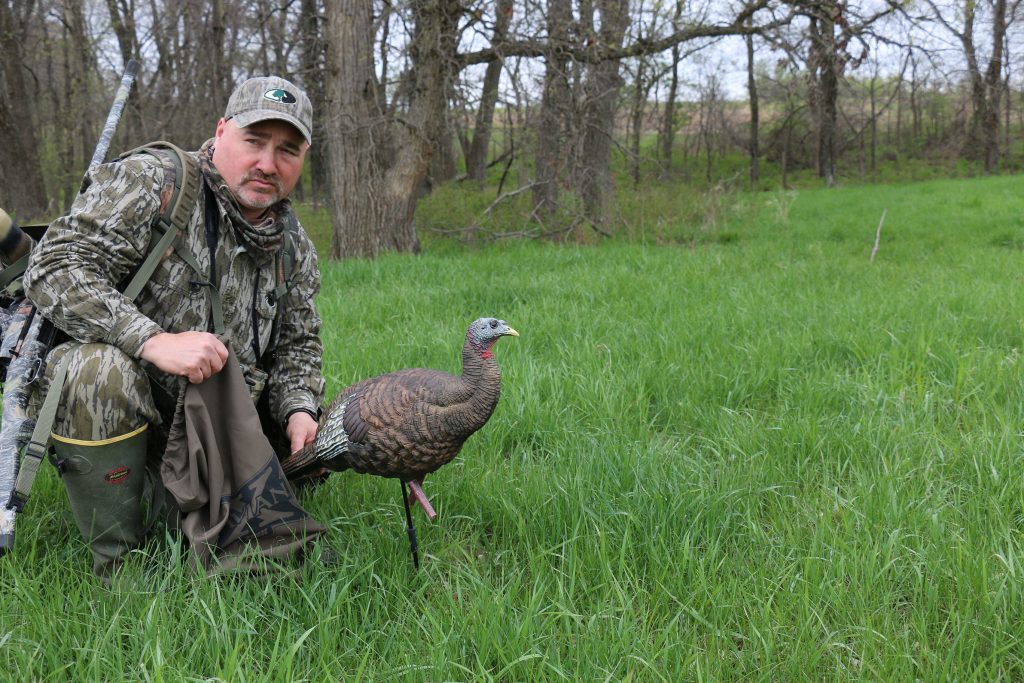You’ve heard the conventional turkey setup advice — find a comfortable spot with a tree wider than your shoulders, and make sure you have clear shooting lanes and a good field of view. Get comfortable, and get ready.
Many folks follow that creed every spring, and it pays dividends. Yet most of those hunters are ignoring an incredibly simple and deadly effective concept when choosing a setup. By doing so, they often wind up frustrated and empty-handed when they could have toted a gobbler from the woods.
Don’t just plop down by a tree this spring. Use this infrequently mentioned terrain consideration to fine tune your setup selection.
Ghost Buster
Legendary turkey hunter Ben Lee often discussed the ghost-gobbler scenario, which goes something like this: Imagine that you’re walking past a cemetery late at night and hear a voice call your name. You look for the source but see nothing. Of course, you probably won’t walk closer to search for the source. In fact, you’ll likely sense that something’s amiss and will leave.
The concept holds true with turkeys. Many hunters set up at areas where a gobbler instinctively knows it should see the “hen” it hears calling but cannot. Common scenarios include large fields or wide-open timber. A longbeard might gobble at calling in such situations, but he likely won’t come within range, sensing that the situation is unnatural. Decoys provide visual reassurance to your calling, of course, but even then, gobblers might stay at a distance while expecting the “hens” to come to them.
Terrain and cover provide the perfect solution. Identify setups where terrain wrinkles, bends in logging roads or even foliage or other natural obstructions hide the source of calling in a natural fashion.
In such cases, gobblers won’t sense trouble, as it seems normal that they cannot see a hen behind a hill or thick timber 100 yards away. Therefore, they’ll have fewer concerns about approaching the calling to seek the source.
Other Considerations
Although a gobbler can’t see a “hen” hidden by terrain, his amazing hearing and instincts let him know almost precisely where the calling source is located. Further, the bird will instinctively know when it should be able to see the source, and he’ll stop and look intently for it when he reaches that mark. As such, you’ll have to shoot the turkey the second it comes into view.
Set up within easy range — say 25 to 40 steps — of slight slopes, logging-road bends, and the edges of thick timber or other visual obstructions. You usually won’t be able to see the turkey approach, so listen for gobbling, drumming, footfalls or other evidence to track his movements.
And be ready, because the second the gobbler pops into view — again, knowing instinctively he should see the hen — he’ll likely stop, crane his neck high and look for the source of calling. Sometimes, birds will pause for a bit to search, but many often look once, sense a silent alarm and start to rubber-neck away. Decoys might pique a bird’s curiosity and make him pause longer.
Either way, you should be prepared to shoot well before the gobbler arrives, with the gun to your shoulder and cheek on the stock, eyes straining for any sign of movement or flash of red or white. When the longbeard appears, raises his head and offers a clear shot, take a deep breath, make sure of your aim and squeeze the trigger. Now.
Sharp Eyes For Setups
After you’ve seen several turkeys react to ideal-terrain setups, it becomes easier to locate such areas. Look for dips, slopes, ridges or low hills while walking and calling. Note bends in trails, stream corridors, cattle paths or other likely turkey travel areas. Identify areas of thick timber, heavy brush or other vegetation that might hide your calling.
Then, put that knowledge to use. Whenever possible, put terrain and cover in your favor before sitting down and calling to a bird. That’s not always feasible, but doing so as often as possible will boost your success substantially. And of course, like any turkey tactic, this approach won’t work all the time. In fact, nothing does. However, setting up with terrain or cover in your favor gives you far greater odds of luring in a curious or fired-up longbeard.
Sure, setting up at such spots won’t let you watch gobbler march 200 yards across a field or strut for hours in sunlit timber. But when you sling him over your back, those visions quickly slip away.
This article originally appeared in the 2017 Whitetail Journal Digital Turkey issue. You can view the entire magazine online here.







